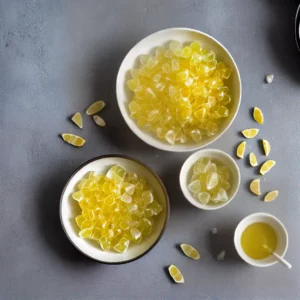How to Cut an Orange
Are you ready to unlock the deliciousness of an orange? Follow this step-by-step guide to learn how to cut an orange like a master chef.
To cut an orange, there are three main techniques: cutting into wedges, cutting into circular slices, and supreming (removing segments from fibrous walls). Before cutting, it’s important to rinse the orange and dry it well. To cut into wedges, slice the orange vertically, then cut crosswise to separate into individual segments. For circular slices, remove the peel and cut horizontally. To supreme, remove the peel and use a paring knife to cut out the segments. When cutting oranges, it’s important to discard the bitter white pith. These various cutting methods can be used for snacking, salads, or cooking. Storage tips include keeping oranges at room temperature for about a week or refrigerating them for up to three weeks.
Key Takeaways – How to Cut an Orange:
- There are three main cutting techniques for oranges: wedges, circular slices, and supreming.
- Rinse and dry the orange before cutting.
- Discard the bitter white pith when cutting oranges.
- Utilize different cutting methods for snacking, salads, or cooking.
- Store oranges at room temperature or refrigerate for extended shelf life.
Now that you have the know-how and techniques to cut an orange, you can confidently prepare this versatile fruit for all your snacking, salad, and cooking needs. Enjoy the refreshing and tangy taste of oranges like a true master chef!
Why Cut Oranges?
Before diving into the cutting techniques, let’s understand why it’s important to cut oranges and how each part contributes to the overall taste and texture. Oranges are a versatile citrus fruit that can be enjoyed in various ways. Cutting oranges allows for easier consumption and enhances their flavor in different dishes.
Oranges consist of several parts, each with its own unique characteristics. The peel, also known as the skin or rind, protects the fruit and contains essential oils that add aroma and flavor. The pith, the spongy white layer beneath the peel, can be bitter and should be removed to improve the taste. By cutting oranges, you can eliminate this bitterness and savor the sweet and tangy flesh.
By cutting oranges into wedges, circular slices, or supreme segments, you can conveniently incorporate them into your snacks, salads, or cooking. Wedges provide a satisfying bite-sized snack, while circular slices are great for garnishing desserts or drinks. Supremes, the juicy segments without any membrane or pith, can be used in fruit salads or as a refreshing addition to dishes.
| Orange Part | Function |
|---|---|
| Peel | Protects the fruit and adds flavor |
| Pith | Bitter layer that should be removed |
| Flesh | Contains sweet and tangy juice |
When cutting oranges, it’s crucial to discard the bitter white pith to fully enjoy the fruit’s delicious taste. The pith can overpower the sweetness of the flesh and negatively impact the overall flavor. By taking the time to properly cut and prepare oranges, you can ensure a delightful culinary experience.

For optimal freshness, oranges should be stored at room temperature for about a week. If you want to extend their shelf life, refrigerating them can keep them fresh for up to three weeks. By following these storage tips, you can enjoy oranges at their peak ripeness and flavor.
The Three Cutting Techniques
Now that you know the importance of cutting oranges, let’s explore the three main techniques: cutting into wedges, slicing into circular pieces, and supreming to extract the juicy segments. Each technique has its own unique method and purpose, allowing you to enjoy oranges in various ways.
Cutting into Wedges
One of the simplest ways to cut an orange is into wedges. Start by rinsing the orange under cold water and patting it dry. Then, using a sharp knife and a stable cutting board, slice off the top and bottom of the orange to create a stable base. Stand the orange upright and carefully cut downward, following the curve of the fruit, to remove the peel and pith. Once the peel is removed, you can see the individual segments. To separate them into wedges, cut crosswise, perpendicular to the core, ensuring each segment is evenly sized. These orange wedges are perfect for snacking or adding a burst of citrus to salads.
Cutting into Circular Slices
Circular slices are another delightful way to enjoy oranges. After rinsing and drying the orange, remove the peel by slicing off the top and bottom. Once the peel is removed, lay the orange horizontally on the cutting board. Using a sharp knife, cut thin, round slices, being careful to maintain an even thickness. These circular slices can be used in desserts, infused water, or as a beautiful garnish for various dishes.
Supreming: Removing the Segments
Supreming is a technique that involves removing the orange segments from the fibrous walls, leaving behind the bitter white pith. To supreme an orange, start by rinsing and drying it thoroughly. Remove the top and bottom of the orange, then cut down the sides to remove the peel and pith, leaving only the juicy flesh. Hold the peeled orange in your hand over a bowl to catch any juices, then use a paring knife to carefully cut along the membrane of each segment. This will release the segment, allowing it to be easily removed. Supremed orange segments are wonderful for adding to fruit salads, desserts, or even savory dishes, providing bursts of citrus sweetness.
Now that you have learned the three main cutting techniques for oranges, you can confidently prepare this versatile fruit for snacking, salads, or cooking. Remember to discard the bitter white pith and experiment with different cutting methods to suit your culinary needs. Enjoy the vibrant flavors of oranges in all their delightful forms!

Before you start cutting into that orange, make sure to give it a thorough rinse under running water to remove any surface impurities. This step is essential to ensure that you are working with a clean fruit, free from any dirt or residue. Simply hold the orange under the faucet and gently rub it with your hands, making sure to cover the entire surface.
After rinsing, pat the orange dry with a clean towel or paper towel. This will help prevent any excess moisture from interfering with the cutting process. It’s important to remember that a dry orange is easier to handle and ensures a more precise and efficient cutting experience. So take a moment to make sure that your orange is completely dry before proceeding to the next step.
Now that your orange is clean and dry, you are ready to begin the cutting process. Whether you choose to cut it into wedges, circular slices, or supreming the segments, the preparation step of rinsing and drying sets the foundation for a successful and enjoyable experience. So take the time to give your orange a little TLC before transforming it into a delicious snack, a refreshing salad ingredient, or a flavorful addition to your favorite recipes.
| Steps Summary: |
|---|
| Rinse the orange under running water to remove impurities. |
| Pat the orange dry with a towel to eliminate excess moisture. |
| Begin cutting the orange into your desired shape or technique. |

Rinsing and drying your orange before cutting it offers several benefits. Firstly, it helps remove any potential contaminants that might be present on the skin, ensuring a cleaner and safer fruit to consume. Additionally, drying the orange allows for better grip and control while cutting, reducing the risk of accidents or uneven cuts. Lastly, by taking the time to rinse and dry the orange, you are showing a commitment to cleanliness and hygiene, which is essential for maintaining good food preparation practices.
Cutting into Wedges
To cut an orange into perfect wedges, follow these simple steps using a sharp knife and a stable cutting board. Firstly, rinse the orange under running water to remove any dirt or residue. Then, dry it thoroughly with a clean towel. This will ensure a clean and hygienic cutting surface.
Next, place the orange on the cutting board and hold it firmly with one hand. With the other hand, take a sharp knife and make a vertical cut through the orange, starting from the top and going all the way down to the bottom. This will divide the orange into two halves.
Now, take one half of the orange and lay it flat on the cutting board. Using a horizontal motion, cut across the orange to create individual segments. Repeat this process with the other half of the orange. And there you have it – perfectly cut orange wedges ready to be enjoyed!

| Step | Instructions |
|---|---|
| 1 | Rinse the orange under running water. |
| 2 | Dry the orange with a clean towel. |
| 3 | Cut the orange vertically into two halves. |
| 4 | Lay one half flat on the cutting board. |
| 5 | Cut across the orange to create individual segments. |
| 6 | Repeat with the other half of the orange. |
Now you can enjoy your freshly cut orange wedges. They are perfect for snacking, adding to salads, or even using as a garnish for drinks or desserts. The possibilities are endless!
Cutting into Circular Slices
If you prefer circular slices of orange for your dishes or snacks, here’s how to achieve that perfect shape by removing the peel and using a sharp knife.
1. Begin by rinsing the orange under cool water to remove any dirt or residue. Pat it dry with a clean towel or paper towel.
2. Using a sharp knife, carefully cut off both ends of the orange. This will create stable surfaces for the following cuts.
3. Standing the orange upright on one of the flat ends, use the knife to slice off the peel from top to bottom, following the contour of the fruit. Make sure to remove all the white pith, as it can be bitter.

4. Once the orange is completely peeled, lay it horizontally on a cutting board. Hold the orange firmly with one hand and use the other hand to cut across the orange into thin circular slices. Aim for slices that are about ¼ inch thick.
5. Depending on your preference, you can leave the circular slices as they are or further cut them into halves or quarters for smaller portions. They are now ready to be used in salads, desserts, or as a refreshing snack!
Remember, always use caution and keep your fingers away from the knife blade while cutting to ensure your safety. Enjoy the delicious taste and beautiful presentation of circular orange slices in your culinary creations!
Supreming: Removing the Segments
Supreming an orange allows you to effortlessly remove the juicy segments from the pithy walls, resulting in a neat and visually appealing citrus treat. To begin, start by carefully removing the peel from the orange using a paring knife. Make sure to remove both the outer peel and the inner pith, exposing the vibrant orange flesh.
Once the peel is removed, hold the orange in one hand over a bowl to catch any juices. Take the paring knife and carefully slice alongside the membranes on both sides of each segment. This will release the juicy segments, separating them from the tough, fibrous walls.
Continue slicing along each membrane until all the segments are freed. As you work, you’ll notice how easily the segments pop out, creating a beautiful presentation. Be sure to collect any remaining juice in the bowl, as it can be used in dressings, sauces, or to simply enjoy as a refreshing drink.
Tip: To make supreming even easier, try chilling the orange beforehand. This helps to firm up the flesh, making it easier to cut cleanly and precisely.
Supreming: Step-By-Step Guide
| Step | Instructions |
|---|---|
| 1 | Using a paring knife, carefully cut off the top and bottom of the orange. |
| 2 | Stand the orange upright on one of the flat ends, and use the knife to cut away the peel and pith, following the curve of the fruit. |
| 3 | Hold the peeled orange over a bowl to catch any juices. Insert the paring knife between the membranes and the flesh on one side of a segment. |
| 4 | Carefully slice along the membrane to the center of the orange, then repeat on the other side of the segment to release it. Repeat this process for all segments. |
| 5 | Collect any remaining juice from the bowl, and use it as desired. |

Now that you’ve mastered the art of supreming an orange, you have a versatile and delicious ingredient to enhance a variety of dishes. Use the supremed orange segments in salads, desserts, cocktails, or even as a vibrant topping for yogurt or oatmeal.
The process of supreming can be a bit tricky at first, but with practice, you’ll quickly become adept at extracting the juicy goodness from the orange while leaving behind the bitter pith. So, the next time you have an orange on hand, give supreming a try and elevate your culinary creations to a whole new level of citrusy delight!
Discarding the Bitter White Pith
To fully enjoy the sweet and tangy flavors of an orange, it’s crucial to remove the bitter white pith. Here’s how to do it properly:
- Start by cutting off the top and bottom of the orange to create stable, flat surfaces.
- Stand the orange upright on one of the flat ends and carefully cut downward to remove the peel, following the curve of the fruit.
- Once the peel is removed, you’ll notice a layer of white pith covering the orange’s segments. This pith contains bitter flavors that can detract from the overall taste of the fruit.
- Using a sharp knife, gently slide the blade between the pith and the fruit, angling it slightly upward.
- Work your way around the orange, removing the pith from each segment by cutting along the fibrous walls.
- Be careful not to remove too much flesh while discarding the pith. Aim to remove only the bitter white layer.
- Once all the pith is removed, your orange is ready to be enjoyed without any lingering bitterness.
Remember, the pith removal process can be messy, so it’s helpful to have a cutting board or plate to catch any juice or pith that may come loose during the process.

| Benefits of Discarding the Pith |
|---|
| Enhances Flavor: By removing the bitter white pith, you allow the natural sweetness and tanginess of the orange to shine through. |
| Improves Texture: The pith can be tough and fibrous, removing it ensures a smoother and more enjoyable eating experience. |
| Enhances Visual Appeal: The bright, vibrant color of the orange segments is more visually appealing without the presence of the white pith. |
Utilizing Different Cutting Methods
Now that you know the diverse cutting techniques, let’s explore the myriad of ways you can use these orange cuts to enhance your snacking, salads, and culinary creations. Whether you choose to cut your oranges into wedges, circular slices, or supreme segments, they can all add a burst of citrusy goodness to your dishes.
For snacking, orange wedges are a convenient and refreshing choice. Their compact size makes them easy to grab and enjoy on the go. Arrange a plate of orange wedges at your next gathering, and watch them disappear as your guests savor the sweet and tangy flavors.
| Snacking | Salads | Cooking |
|---|---|---|
| Enjoy orange wedges as a standalone snack. | Add orange slices to green salads or fruit salads for a burst of freshness. | Use supremed orange segments as a topping for grilled fish or roasted chicken. |
| Make a refreshing orange-infused water by adding wedges to a pitcher of water. | Combine orange slices with mixed greens, feta cheese, and walnuts for a vibrant salad. | Use circular orange slices to garnish desserts like cakes or tarts. |
| Create a quick and easy snack by pairing orange wedges with cheese or yogurt. | Toss orange segments with arugula, red onion, and a citrus vinaigrette for a zesty salad. | Add supremed orange segments to stir-fries or sautéed vegetables for a pop of flavor. |
In salads, oranges can bring a delightful burst of citrus to your greens. Whether you prefer wedges, circular slices, or supreme segments, they can add a vibrant touch to your salad creations. Pair them with mixed greens, feta cheese, and walnuts for a refreshing combination of flavors.
When it comes to cooking, the possibilities are endless. Use supremed orange segments as a topping for grilled fish or roasted chicken to add a bright and juicy element to your savory dishes. For desserts, circular orange slices can be the perfect garnish for cakes or tarts, providing both visual appeal and a hint of citrus sweetness.
Remember, storage is key to preserving the freshness of your cut oranges. Keep them at room temperature for about a week or refrigerate them for up to three weeks. So go ahead, unleash your creativity in the kitchen and let the vibrant flavors of oranges enhance your snacking, salads, and culinary creations!

Proper storage is key to keeping your oranges fresh and juicy. Follow these storage tips to ensure maximum flavor and shelf life.
Room Temperature Storage
Oranges can be stored at room temperature for about a week, making them easily accessible for quick snacking or adding to recipes. It’s important to keep them in a cool, dry place away from direct sunlight or heat sources. This helps to maintain their flavor and prevent them from drying out.
Refrigeration for Extended Shelf Life
If you want to extend the shelf life of your oranges, refrigeration is the way to go. Wrap each orange individually in a paper towel or place them in a breathable bag to prevent excess moisture buildup. This will help to preserve their freshness and prevent them from spoiling too quickly. Stored properly, oranges can last up to three weeks in the refrigerator.
Table: Storage Tips for Oranges
| Storage Method | Duration |
|---|---|
| Room Temperature | Up to 1 week |
| Refrigeration | Up to 3 weeks |
By following these storage tips, you can enjoy the sweet and tangy taste of fresh oranges for longer. Whether you’re using them for snacking, salads, or cooking, properly stored oranges will always add a burst of flavor to your dishes.

Remember, to keep your oranges at their best, rinse and dry them before cutting. Discard the bitter white pith when preparing your oranges, as it can affect the taste of the fruit. With these storage tips and proper preparation techniques, you can make the most of your oranges and enjoy their deliciousness any time.
Orange Varieties and Flavors
Oranges come in a variety of types, each with its own distinct flavor profile. Let’s delve into the characteristics of some popular orange varieties.
| Variety | Flavor |
|---|---|
| Navel | The navel orange is known for its sweet and slightly tangy flavor. It has a juicy and seedless flesh, making it perfect for snacking. |
| Blood Orange | Blood oranges have a rich, deep red flesh that can range from sweet to slightly tart. They often have berry-like undertones, making them a popular choice for unique citrus flavors. |
| Mandarin | Mandarins have a sweet, honey-like flavor with a refreshing citrus aroma. They are easy to peel and often enjoyed as a convenient snack. |
| Clementine | Clementines are small, seedless oranges with a vibrant, bright flavor. They are known for their easy-to-peel skin and are a popular choice for lunchboxes and on-the-go snacking. |
| Tangerine | Tangerines have a tangy and sweet flavor that is often described as being more intense than that of an orange. They are easily recognizable by their loose, easy-to-peel skin. |
| Valencia | Valencia oranges have a balanced sweet-tart flavor. They are popular for their juiciness and are often used for making orange juice. |
| Cara Cara | Cara Cara oranges have a sweet and tangy flavor with hints of berry and cherry. They have a vibrant pink flesh, making them visually appealing as well. |
Each of these orange varieties brings its own unique flavor to the table, allowing for a wide range of taste experiences. Whether you prefer the sweet and tangy navel orange or the rich and distinctive flavor of a blood orange, there is an orange variety to suit every palate.
“Oranges are like sunshine in fruit form.” – Unknown
So the next time you reach for an orange, consider trying a different variety to explore new and exciting flavor profiles. Whether you enjoy them as a snack, in salads, or as an ingredient in your favorite recipes, oranges can add a burst of citrus goodness to any dish.

- Oranges come in a variety of types, each with its own distinct flavor profile.
- Popular varieties include navel, blood orange, mandarin, clementine, tangerine, valencia, and cara cara.
- Each variety has its own unique flavor characteristics, ranging from sweet and tangy to rich and intense.
- Consider trying different orange varieties to explore new and exciting flavor profiles.
Nutritional Benefits of Oranges
Oranges not only tantalize our taste buds but also provide a plethora of essential nutrients. Discover why oranges are a nutritional powerhouse.
One of the biggest health benefits of oranges is their high vitamin C content. Just one medium-sized orange can provide you with more than 90% of your recommended daily intake of this immune-boosting vitamin. Vitamin C is an antioxidant that helps protect our cells from damage, supports collagen production for healthy skin, and enhances iron absorption for optimal energy levels.
In addition to vitamin C, oranges are packed with other key nutrients. They are rich in dietary fiber, which aids in digestion and helps to maintain healthy cholesterol levels. Oranges also contain folate, a B-vitamin that is essential for cell division and the formation of DNA. Furthermore, oranges are a great source of potassium, an electrolyte that supports proper heart and muscle function.
| Nutrient | Amount per 100g of Orange |
|---|---|
| Vitamin C | 53.2mg |
| Fiber | 2.4g |
| Folate | 30mcg |
| Potassium | 181mg |
“Oranges are not only delicious but also a great source of essential nutrients.”
Including oranges in your diet can have numerous health benefits. The combination of vitamin C, fiber, and other nutrients makes oranges a great addition to a balanced diet. They can help boost your immune system, improve digestion, and support overall well-being.
So, the next time you reach for a snack or need a burst of refreshment, grab an orange and enjoy its sweet and tangy flavor, knowing that you are fueling your body with vital nutrition.

To achieve clean and precise cuts, having the right tools for cutting oranges is essential. Let’s explore the knives and cutting boards that will make your orange cutting experience a breeze.
1. Paring Knife: A paring knife is a small, sharp knife that is perfect for intricate tasks like peeling oranges and removing their segments. Its narrow blade allows for precise cuts, ensuring you can easily separate the orange flesh from the fibrous walls.
2. Chef’s Knife: A chef’s knife is a versatile tool that can be used for various cutting tasks, including slicing oranges into circular segments. Its broad and sturdy blade provides stability and control, allowing you to achieve even slices with ease.
3. Serrated Knife: A serrated knife, also known as a bread knife, is excellent for cutting through the tough skin and peel of an orange. The serrated edge allows for easy grip and sawing motion, making it effortless to remove the outer layer of the orange.
When using any of these knives, it’s important to have a stable cutting board to ensure safety and precision. A wooden or plastic cutting board with non-slip grips is recommended to provide a secure surface for cutting oranges.
With the right tools at hand, you can confidently prepare oranges for snacking, salads, or cooking, knowing that you’ll achieve clean and precise cuts every time.

Take your culinary creations to the next level by incorporating orange garnishes and zest, adding a burst of flavor and a touch of visual appeal. Orange garnishes are not only aesthetically pleasing but also provide an extra layer of taste to your dishes. From sweet to tangy, oranges can complement a wide range of flavors, making them a versatile ingredient for garnishing.
To create a simple orange garnish, start by using a small, sharp knife to carefully cut thin slices of orange peel. These can be used as decorative elements on cakes, cocktails, or even savory dishes. The vibrant color and citrus scent of the peel add a refreshing twist to your culinary creations.
Another way to incorporate the essence of oranges into your dishes is by using orange zest. Zest refers to the outermost layer of the orange peel, which contains aromatic oils bursting with flavor. To create zest, use a zester or small grater to gently scrape the peel, being careful to avoid the bitter white pith. Sprinkle the zest on top of salads, desserts, or any dish that could benefit from a hint of citrus.

| Garnish Ideas | Flavor Profile |
|---|---|
| Orange Twist | Bright and citrusy |
| Candied Orange Peel | Sweet and chewy |
| Orange Zest Sprinkle | Fragrant and tangy |
| Orange Segments | Juicy and refreshing |
Experiment with different orange garnishes and zest to find the perfect balance of flavors for your dishes. Whether you’re adding a touch of sweetness to a savory meal or refreshing a dessert, the versatility of oranges allows for endless creative possibilities. So, grab an orange and elevate your culinary creations today!
Other Orange Uses: Juice and Squeezing
Oranges are not only meant to be cut and consumed, but they also offer a refreshing juice that can be extracted using various techniques. Whether you enjoy a tall glass of fresh orange juice in the morning or need citrus juice for a recipe, here are some methods for extracting the juice from oranges.
Juicer: Using a juicer is a quick and efficient way to extract orange juice. Simply cut the orange in half and place one half on the juicer, applying gentle pressure. The juicer will filter out the pulp and seeds, leaving you with pure orange juice. Repeat the process with the other half of the orange.
Manual squeezing: If you don’t have a juicer, you can still enjoy freshly squeezed orange juice. Start by rolling the orange on a hard surface to release the juices. Cut the orange in half and use a citrus reamer or a fork to squeeze the juice out into a bowl or glass. Be sure to strain out any pulp or seeds before serving.
Now that you know how to extract orange juice, you can enjoy it on its own or use it in various recipes. From citrus-infused marinades and dressings to refreshing cocktails and smoothies, the possibilities are endless. So next time you have a surplus of oranges, put them to good use by creating delicious and nutritious orange juice.

| Orange Juice Recipes |
|---|
| Orange Creamsicle Smoothie |
| Ingredients: |
| – 2 oranges, juiced |
| – 1 banana |
| – 1 cup vanilla yogurt |
| – 1 cup ice |
| Instructions: |
| 1. In a blender, combine the orange juice, banana, yogurt, and ice. |
| 2. Blend until smooth and creamy. |
| 3. Pour into glasses and serve. |
| Fresh Orange Margarita |
| Ingredients: |
| – 2 oranges, juiced |
| – 2 ounces tequila |
| – 1 ounce triple sec |
| – 1 ounce lime juice |
| – Salt for garnish (optional) |
| Instructions: |
| 1. Fill a shaker with ice and add the orange juice, tequila, triple sec, and lime juice. |
| 2. Shake well to combine. |
| 3. Rim a glass with salt (optional) and pour the margarita mixture into the glass. |
| 4. Garnish with an orange slice and serve. |
Conclusion – How to Cut an Orange
Cutting an orange is a simple yet important skill that can elevate your culinary endeavors. With these techniques and tips, you’re now equipped to enjoy the juicy goodness of oranges in various ways.
There are three main cutting techniques for oranges: cutting into wedges, cutting into circular slices, and supreming. Each technique offers a different way to enjoy the refreshing taste of oranges. Whether you prefer the convenience of bite-sized wedges, the aesthetic appeal of circular slices, or the elegance of supremed segments, there’s a cutting method to suit your needs.
Before cutting, it’s crucial to rinse and dry the orange thoroughly. This ensures that you’re working with a clean fruit, free from any dirt or residue. Additionally, be sure to discard the bitter white pith when cutting oranges. Removing the pith enhances the flavor and sweetness of the fruit.
When it comes to storage, keeping oranges at room temperature for about a week is ideal for immediate consumption. If you want to extend their shelf life, refrigerating them for up to three weeks is recommended. So, stock up on these citrus gems and savor their refreshing taste whenever the mood strikes.
FAQ – How to Cut an Orange:
Q: How do I cut an orange into wedges?
A: To cut an orange into wedges, slice it vertically, then cut crosswise to separate into individual segments.
Q: What is the process for cutting an orange into circular slices?
A: To cut an orange into circular slices, remove the peel and cut horizontally.
Q: How do I supreme an orange?
A: To supreme an orange, remove the peel and use a paring knife to cut out the segments from the fibrous walls.
Q: Should I rinse the orange before cutting it?
A: Yes, it’s important to rinse the orange before cutting to remove any dirt or residue.
Q: Can I store oranges at room temperature?
A: Yes, you can keep oranges at room temperature for about a week.
Q: How long can I refrigerate oranges?
A: Oranges can be refrigerated for up to three weeks.
Our Friends:
- https://www.thekitchn.com/how-to-cut-an-orange-23490274
- https://www.jessicagavin.com/how-to-cut-an-orange/
Related Recipes:
 How to Freeze Oranges: Keep Citrus Fresh for Longer
How to Freeze Oranges: Keep Citrus Fresh for Longer
 How to Store Oranges? (Perfect Every Time!)
How to Store Oranges? (Perfect Every Time!)
 How to Cut Dragon Fruit? (Perfect Step-By-Step Guide)
How to Cut Dragon Fruit? (Perfect Step-By-Step Guide)
 How to Cut a Watermelon? (Perfect Step-By-Step Guide)
How to Cut a Watermelon? (Perfect Step-By-Step Guide)
 How to Cut a Tomato? (Perfect Step-By-Step Guide)
How to Cut a Tomato? (Perfect Step-By-Step Guide)
 How to Cut Green Onions? (Step-By-Step Guide)
How to Cut Green Onions? (Step-By-Step Guide)
 How to Freeze Passion Fruit? (Step-By-Step Guide)
How to Freeze Passion Fruit? (Step-By-Step Guide)
 How to Cut a Kiwi? (Perfect Step-By-Step Guide)
How to Cut a Kiwi? (Perfect Step-By-Step Guide)








